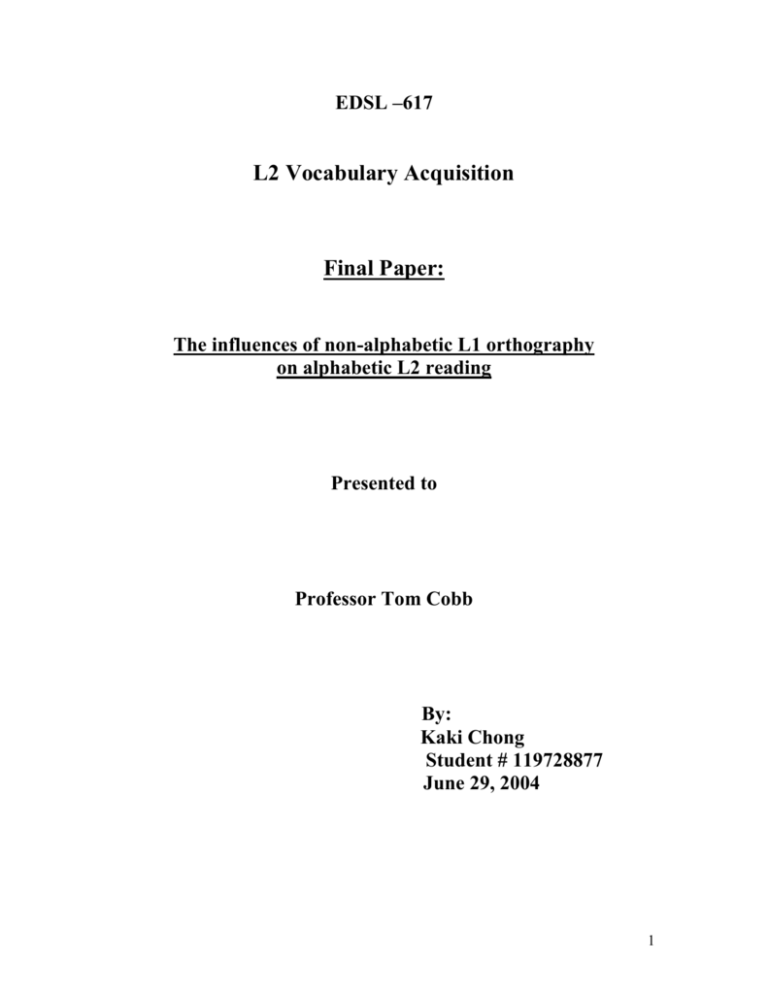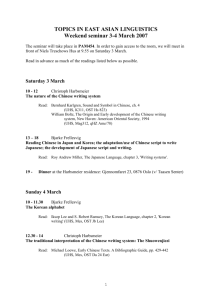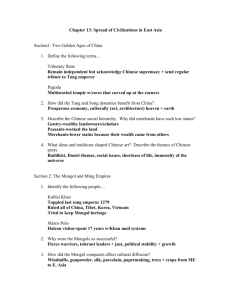asst_04__kaki_29Jun_1630
advertisement

EDSL –617 L2 Vocabulary Acquisition Final Paper: The influences of non-alphabetic L1 orthography on alphabetic L2 reading Presented to Professor Tom Cobb By: Kaki Chong Student # 119728877 June 29, 2004 1 Introduction In Second Language Acquisition, first language (L1) influence on second language (L2) reading has been investigated by many researchers in recent years. Most literature on second language acquisition indicates that many L2 learners are likely to transfer their L1 reading skills to their L2 reading. The different language structure and writing systems of L2 learners’ first language such as phonology, orthography, semantic and syntactic structure affect the processing of L2 word recognition and meaning. Many researchers presumably suggest that the greater the distance between L1 and L2, the more difficulties the learners will encounter in their L2 reading. For example, when one’s L1 has a non-alphabetic background, the transfer may cause him or her to encounter difficulty in reading an alphabetic L2. As a Chinese learner of English for many years, I have always been fascinated by the process in which I have learned to read English, an alphabetic language, being rooted as I am in the background of a non-alphabetic language. In studying theory, my experience correlates with the findings of many studies. In the process of learning to read, basic processing skills are required. Lower-order processing is considered to be one of the foundational components of reading (Muljani, Koda & Moates, 1998). “Lower-order processing refers to the point of fixation to lexical access” (Stanovich 1991, as cited in Akamatsu, 1999, p. 381). Therefore, I am interested in understanding how the orthography of non-alphabetic L1 influences alphabetic L2 reading, a phenomenon that echoes my own experience. In this paper, I intend to look at the effects of the orthographic features in non-alphabetic L1 on word recognition in English as an L2 and how this process takes place. I have chosen to focus on three non-alphabetic languages in 2 particular: Chinese, Korean and Japanese. The aim of this paper is to develop questions for further study in this particular field. An introduction of the three non-alphabetic languages will be followed by a discussion of their effects on English word recognition processing. The three focus languages The writing systems of non-alphabetic and alphabetic languages select different units of spoken language for mapping. Non-alphabetic language speakers are logographic, meaning readers who mainly rely on the shape of characters for word recognition when they read (Akamatsu, 1999). On the other hand, alphabetic language speakers are considered to be phonographic, meaning readers who understand the meaning of a written word through the way it sounds in speech. Chinese is logographic; Korean is syllabic, and Japanese is a combination of logographic and syllabic. By reviewing the literature on how the speakers of these languages read English, I will explore to what degree the orthography of non-alphabetic L1 affects alphabetic L2 reading. Before discussing their influences on English reading, one must have a basic grasp of the language structure of Chinese, Korean and Japanese. Chinese Characters Chinese characters have a very complex visual-orthographic structure compared to English. They are composed of twenty-four basic strokes that are combined according to certain positional constraints to form more than five hundred radical components, which are likewise combined according to certain positional constraints to form characters (Chinese Radical Position Frequency Dictionary, 1984 as cited in Wang, Kada & Perfetti, 2003). Each character represents the meaning of a whole syllable, and the 3 appearance of a character is often not predictably related to its pronunciation. Therefore, the characters can be classified as logographic (Jackson et al. 1994 as cited in Jackson, Chen, Goldsberry, Kim & Vanderwerff, 1999). Due to the complexity of character formation, the visual distinctiveness between any two characters varies widely and the set of characters as a whole is a daunting task of visual discrimination. Furthermore, the correlation between visual form and pronunciation in Chinese characters is weak even at the whole character level. Thus, two characters that have similar pronunciation often share no visual resemblance (Wang et al., 2003). As a result, it is expected that the semantic meaning of Chinese characters is assessed directly from its orthography rather than phonology (Akamatsu 1999; Jackson et al. 1999, Koda 1989; Wong & Chen 1999; Wang, Koda & Perfetti 2003). Korean The Korean writing system consists of Hanja and Hangul. Composed of logographic characters borrowed from Chinese, the characters of the Hanja writing system have the same graphic presentation and meaning as the original Chinese characters. In terms of phonology, Hanja characters have approximately the same sound of the corresponding Chinese characters but without tones. Hanja has rarely been used for the past several decades. There are about one thousand eight hundred Hanja characters still currently in use for educational purposes. Hanja is usually used for emphasis much like using italics or bold type in English. It is also used to resolve homography in Korean because each meaning of a Hangul homograph will map onto a different Hanja character. Moreover, Hanja words directly represent meaning but not phonology; their meanings are 4 assumed to be activated from orthography instead of phonology. In Korea, children begin to learn Chinese Hanja only in middle school. On the other hand, Hangul is considered to be alphabetic and was invented in the 15th century. Hangul has twenty-four letters and each represents a phoneme of the Korean language. Although Hangul is an alphabet, the alphabetic characters are written like a syllabary in which two or more letters are clustered into a syllabic block. Since Hangul is fundamentally a phonetic script, each syllable block can be pronounced by analyzing it into its constituent phonemes. Hangul is used more frequently than Hanja in Korea because Korean grammatical morphemes can only be written in Hangul. In addition, the alphabetic words in Hangul encode phonological information directly and unambiguously. Therefore, the word recognition and meaning processing of Hangul are assumed to be phonologic. Phonological information presumably plays a major role in the processing of printed Hangul words. (Cho & Chen, 1999). In sum, Korean is a language consisting of both logographic and syllabic systems. Japanese Japanese writing system is made up of kanji and kana scripts. Kana, are the characters used to represent phonological units and restricted to only one pronunciation for each character. The other system, kanji, is composed of logographic characters of Chinese origin and used to represent morphemes of spoken Japanese. Each kanji character has phonetic as well as semantic value. According to the Database for the 1, 945 Basic Japanese kanji characters (Tamaoka, Kirsner, Yanase, Miyaoka & Kawakami 2001, 2002 as cited in Morita & Tamaoka 2002), approximately sixty percent of these Kanji characters have two kinds of pronunciations: Kun-reading and On-reading. When 5 Chinese characters were introduced in Japan, their pronunciations were adopted as Onreading, which as the sound of Chinese characters, into the Japanese written language. About sixty-two percent of commonly used kanji characters were assigned a Japanese pronunciation that is known as Kun-reading. Therefore, when reading two-kanji compound words, appropriate pronunciation is determined by the specific combinations of two or more kanji characters. Due to the complex characteristics of kanji pronunciation, there is a common belief that phonological activation, the process by which readers connect sound and character, is absent in kanji reading. The relationship of orthography and phonology in reading nonalphabetic languages In order to understand the way in which a non-alphabetic L1 influences the cognitive processing in learning to read an alphabetic L2, it is necessary to understand the relationship of orthography to phonology, print to sound, in reading literature. In the process of word identification across writing systems, there are three underlying lexical constituents that are examined by many research studies on reading. They are: orthography, phonology, and semantics. Many researchers agree that there are two routes in reading for meaning. Coltheart and his colleagues proposed a ‘dual-route model’ in which there are two routes for translating printed words into sound (Coltheart, Curtis, Atkins & Haller 1993;Wang et al. 2003). The basic concept of dual-route models of reading is that skilled readers have two procedures for converting print to speech: called ‘lexical route’ or ‘direct route’, and the ‘non-lexical route’ or ‘assembled route’. In the lexical route, words that readers have learned are represented as an entry in a mental dictionary. Therefore, such words can be read aloud by accessing the lexical entry of the 6 words from their printed form. The reader can then retrieve the pronunciation of the words. In other words, if one takes this route in reading, he or she is able to recognize how a word is pronounced on the basis of graphic information without reference to the word’s phonology. According to Coltheart et al. (1993), Chinese reading is an example of lexical route strategy. This reading strategy can be simply understood as a route from orthography to semantic ( O S). The second route in the dual-route model is called the ‘non-lexical route’ or ‘assembled route’. The ‘non-lexical route’ refers to an indirect reading pathway for word recognition from visual word recognition to a semantic system and then from semantic system to spoken and written word production. This route can be represented as a formula: OPS. This is the strategy usually used for English reading. Native English readers usually perceive the orthography of the letter strings, and then reach the pronunciation by the given phonological information and subsequently arrive at an accurate semantic meaning of the word. Since the non-lexical route allows the correct pronunciation of English words by obeying the phonetic rules of English, readers can also read aloud any pronounceable letter strings and even gibberish through such a reading route (Coltheart et al.1993; Koda 1989; Lesh & Pollatsek 1993; Wang et al. 2003). The effects of orthography and phonology in reading non-alphabetic and alphabetic language Orthographic effects Non-alphabetic orthography complicates the process of English word recognition for Chinese, Korean and Japanese ESL learners. Due to their logographic and syllabary 7 background, they are accustomed to replying on graphic information in their L1 reading. Therefore, they are presumably considered to be sensitive to the visual shape of an English word. According to Akamatsu (1999), the process of English word recognition for Chinese and Japanese ESL learners is impaired by case manipulation. In Akamatus’ study, the fluent ESL readers of Persian (alphabetic L1), Chinese (non-alphabetic L1) and Japanese (non-alphabetic and alphabetic L1) were asked to recognize genuine English real words through case alternation (e.g CaSe AlteRnAtioN). The stimuli, real English words, consisted of forty high-frequency and forty low-frequency words. In each set of words, there were twenty regular and twenty exception words. Their speed of word recognition was recorded. The result of this study indicated that the case alternation had a smaller impact on the Persian ESL students’ word recognition than on that of the Chinese and Japanese students. The Chinese and Japanese participants spent more time on comprehending the case alternated English words than the Persian participants. Such findings could be explained by the dual route reading strategy mentioned before. Since Persian is an alphabetic language, phonology should play a role in reading. Therefore, Persian speakers should rely on the non-lexical route, OPS, to decode a word. In the study by Akamatsu, the phonological component in Persian helped speakers to reduce the impairment of word recognition by distorted letter strings. Therefore, they were able to recognize an English word faster than Chinese and Japanese speakers. On the other hand, the non-alphabetic L1 background of Chinese and Japanese speakers hindered the word recognition process. Since Chinese and Japanese are used to reading through a lexical route, they are more sensitive to the visual shape of a word. 8 Therefore, when the cases of the English words are altered, they needed a longer time to recognize the words. Similarly, the syllabary writing system of Hangul also impedes the English word recognition by Korean speakers. According to Jackson et al. (1999), the Korean university graduates recognized case altered English words significantly slower than the eighth grade native English speakers. All these findings suggested that the orthography is predominant in non-alphabetic reading and thus delays the process of English word recognition of the ESL learners. Note that the slow speed of word recognition does not represent semantic comprehension. Thus, whether the delayed word recognition of nonalphabetic L1 ESL learners would impede English reading comprehension is still uncertain. Phonological effects Although many research studies have investigated the role of phonology in nonalphabetic and alphabetic reading, there are still an inconsistent pattern of results on this issue. Many researchers believe that phonology plays a less dominant role in logographic languages such as Chinese, Korean Hanja and Japanese Kanji readings. They presume the visual information given in these writing systems directly represent sound and meaning for readers, and thus a lexical route is considered to be the prevalent reading strategy. Such theory has been determined by a preponderance of studies in which nonalphabetical readers are usually less sensitive to English homophones than English native speakers or other alphabetic language speakers. For example, Chinese speakers usually make less error and take less time to identify English homophones than Japanese or Korean. It is because they mainly rely on visual information to distinguish the meanings 9 of English homophones rather than relying on the phonological information. As a result, the lack of phonology activation in Chinese reading becomes the impediment to peseudoword identification in English ( Koda, 1989; Wong & Chen, 1999; Wang et al., 2003). Moreover, generally speaking, Korean and Japanese speakers tend to be more sensitive to homophone identification in English and are quicker to identify the pseudowords than the Chinese speakers (Akamashu 1999; Koda 1984; Jackson et al. 1999; Wang et al 2003). This phenomenon can be explained by the different orthographies of Chinese, Korean and Japanese. Since phonology is involved in Hangul and Kana reading, Korean and Japanese are assumed to be familiar with alphabetic writing systems. Therefore, when they are asked to identify English homophones and pseudowords, they are more likely to activate the non-lexical route, which relies heavily on phonological information in the reading process, instead of the lexical route (Akamashu 1999; Koda 1984; Jackson et al. 1999; Lesch & Pollatsek, 1993; Wang et al 2003). While many studies indicate that having an alphabetic language background helps in identifying English words, Koda (1984) assumed that phonological recoding is a necessary step to mediate the semantic coding in English. This assumption is based on the fact that the mental lexicon of English is organized phonologically. As a result, the non-lexical route should be activated in English reading (Koda, 1984). Hence, native English speakers could easily identify English pesudowords and were more impaired in English homophones identification compared with other non-alphabetic language speakers (Akamashu 1999; Koda 1984; Jackson et al. 1999; Wang et al 2003). 10 This is evidence further supports the argument that the involvement of phonology plays a crucial role in the differentiation of alphabetic and non-alphabetic language reading. However, recent research indicated that phonology activation does occur in nonalphabetic reading and thus suggests that the orthographic effect can no longer be the main reason to explain the difficulty in English word recognition. The study by Cho & Chen (1999) reported that phonology contributes to Hanja word recognition to a varying degree according to the reading skills of Hanja readers. The findings of this study showed that less skilled Hanja readers were more likely to have homophony effect, having errors or long reaction time in word recognition due to the same sounds of two characters, but not the skilled readers. In other words, if asking the less skilled and skilled Hanja readers to identity English homophones, they may get different results in accuracy and reaction time in the word recognition. The inconsistent findings on the role that phonology plays for speakers of non-alphabetic and alphabetic languages seem to suggest that the level of proficiency in the participants’ non-alphabetic L1 needs to be taken into account in further studies. However, these studies verified that the reading strategy from the nonalphabetic L1 was transferred to the reading strategy for the alphabetic L2 alphabetic. Is the word recognition modularized? The different reading strategies being applied in non-alphabetic and alphabetic reading gives rise to a question with respect to word recognition in L2: if two languages in different orthographies such as English and Chinese require either lexical or nonlexical route in the process of word recognition, can either one of these mechanisms be assumed to be fossilized in the reading unit of skilled readers? In other words, if a 11 language’s orthographic characteristics of words are central to the formulation of the processing mechanism for word recognition, the formulation of such processing in L2 essentially depends on the orthographic features of the L2 (Coltheart et al., 1993). Stanovich (1991) also proposed that the information processing mechanism for word recognition in the L2 is modularized, and thus fluent L2 readers should develop a specific mechanism for recognizing L2 words (as cited in Akamatsu, 1999). For example, fluent ESL learners should have specific input systems modularized for English word recognition and thus the word processing would not be disturbed by the orthographic features of their L1. Furthermore, one may hypothesize that the structure of the input systems should be more or less the same across the board for fluent ESL readers. It is because the orthographic features of English become central to the formulation of input systems. Recalling the findings in the study by Akamatsu (1999) that the Chinese and Japanese readers had more difficulty in recognizing the cased altered English words, it was found that they spent more time in the word recognizing process than the Persian speakers because they were more sensitive to orthographic information as opposed to phonological information. This result suggested that the deep word recognition mechanism of the Chinese and Japanese speakers could not be modified. Therefore, in spite of the high ESL proficiency of these participants, their word recognition process in English was hindered. However, if the word recognition mechanism of one’s L1 is modularized, should he or she also develop a specific word recognition mechanism for his or her L2 and have it modularized? If the theory of modularization is valid, the nonalphabetic L1 ESL learners should have no difficulty in English word recognition 12 because they deal with the recognition through a different route. In other words, there should be no L1 reading strategy transferred. Therefore, the theory of modularization is premature and merits further study to assess its veracity. Suggestion and Conclusion By looking at the effects of Chinese, Korean and Japanese on English word recognition, I was able to understand how the discrepancies among these non-alphabetic language systems affect alphabetic reading. The literature review deepened my comprehension of how Chinese, Korean and Japanese speakers selectively take a lexical route or non- lexical route in a varying degree according to the writing system of their L1. Due to the logographic and syllabary background of the ESL learners in the three groups, their sensitivity towards graphic information brings them difficulty in perceiving the phonology manipulated English. Since most of the previous research investigated the reaction time on word recognition processing, the findings of those studies cannot completely represent the effect of a non-alphabetic L1 on alphabetic L2 reading. Perhaps the meaning processing should also be taken into consideration by proceeding to a think aloud protocol in further studies. Since the orthography feature is predominant in non-alphabetic reading, Chinese, Japanese and Korean ESL learners have difficulty accessing the non-lexical route in English word recognition processing. However, some research suggested that the proficiency of the participants’ L1 can determine the degree of the difficulty. Therefore, a consistent level of L1 proficiency of the participants in similar research studies is needed. 13 Some researchers such as Colheart and Akamastu presumed that the orthographic effects on English reading is due to language modularization. Chinese, Korean and Japanese learners are not able to modify the modularized word recognition mechanism of their L1 and thus they encounter difficulties in English word recognition. However, I have reservations for such a theory and think that it needs further investigation. For an example I mentioned before the problem of modularization. In conclusion, this literature review allows me to develop questions for further study on the effects of a non-alphabetic L1 on alphabetic L2 reading. Besides the questions on research design, a possible pedagogical question is whether or not teaching non-alphabetic L1 ESL learners the application of a non-lexical route will be helpful in their English lexical learning. Would the instructional background of the non-alphabetic speakers such as their late exposure to English play a role in word recognition fossilization or development? Finally, I hope that there will be future studies that would provide not only theory but also the pedagogical implications on the issue. 14 References Akamatsu, N. (1999). The effects of first language orthographic features on word recognition processing in English as a second language. Reading and Writing: A Interdisciplinary Journal, 11, 381-403. Cho.,J.R., & Chen, H.C. (1999). Orthographic and activation in the semantic processing of Korean Hanja and Hangul. Language And Cognitive Processes, 14, 481-502. Coltheart, M., Curtis, B., Atkins, P., & Haller, M. (1993). Models of reading alound: dual-route and parallel-distributed-processing apprachese. Psychological Review, 100, 589-608. Jackson, N.E., Chen, H., Goldsberry. L., Kim, & Vanderwerff, C. (1999). Effects of Variations in orthographic information on Asian and American readers’ English text reading. Reading and Writing A Interdisciplinary Journal, 11, 345-379. Kinoshita, S. (1998). The role of phonology in Japanese: or why I don’t hear myself when I reading Japanese. Reading and Writing: An Interdisciplinary Journal, 11, 345-379. Koda, L. (1989). The use of L1 reading strategies in L2 reading: effects of L1 orthographic structures on L2 phonological recoding strategies. Second Language Acquisition, 12, 393-410. Lesch, M.F., & Pollatsek, A. (1993). Automatic access of semantic information by phonological codes in visual word recognition. Journal of Experimental Psychology: Learning, Memory, and Cognition, 19, 285-294. 15 Morita, A. & Tamaoka, K. (2002). Phonological involvement in the processing of Japanese at the lexical and sentence levels. Reading and Writing: An Interdisciplinary Journal, 15, 633-651. Muljani, D., Koada, K., & Moates, D. R. (1998). The development of word recognition in a second language. Applied Psycholinguistics, 19, 99-113. Wang, M., Koda, K. & Perfetti, A. (2003). Alphabetic and nonalphabetic L1 effects in English word identification :a comparison of Korean and Chinese English L2 Learners. Cognition, 87, 129-149. Wong, K.F.E., & Chen, H.C. (1999). Orthographic and phonological processing in reading Chinese text: evidence from eye fixations. Language And Cognitive Processes, 14, 467-480. 16





